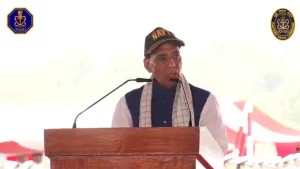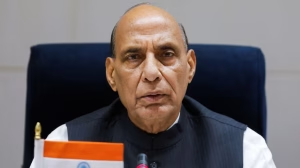Madhya Pradesh – Defence Minister Rajnath Singh delivered a significant Rajnath Singh Statement On War on Wednesday, emphasizing that India must remain prepared for both short and long-duration conflicts. Speaking at the prestigious Ran Samwad military conclave in Mhow, Madhya Pradesh, the Rajnath Singh Statement On War highlighted how new technologies have fundamentally transformed the nature of warfare, making it increasingly difficult to predict conflict duration.
The comprehensive Rajnath Singh Statement On War addressed the evolving landscape of modern warfare, where traditional military parameters no longer guarantee victory. The Defence Minister stressed that precision-guided weapons and real-time intelligence have emerged as critical factors determining success in contemporary conflicts, marking a significant shift from conventional warfare strategies.
Technology Transforms Modern Warfare Dynamics

The Rajnath Singh Statement On War specifically outlined how technological advancement has revolutionized military operations across multiple domains. According to the Defence Minister, wars could potentially stretch from a few months to several years, requiring nations to fundamentally rethink their approach to future conflicts. This aspect of the Rajnath Singh Statement On War underscores the unpredictable nature of modern warfare.
“In today’s era, it is very difficult to predict when a war will end. We must be prepared for every situation,” the Defence Minister explained during his Rajnath Singh Statement On War. He emphasized that India must maintain sufficient surge capacity to sustain conflicts lasting two months, four months, one year, two years, or even five years, demonstrating the comprehensive nature of required military preparedness.
The Rajnath Singh Statement On War highlighted that sheer numbers of soldiers or weapon stockpile size are no longer sufficient indicators of military strength. Instead, technological superiority and strategic implementation have become decisive factors in determining conflict outcomes.
Cyber Warfare and Artificial Intelligence Integration


A crucial component of the Rajnath Singh Statement On War focused on emerging technological domains that now shape military operations. The Defence Minister identified cyber warfare, artificial intelligence, unmanned aerial vehicles, and satellite-based surveillance as key elements shaping future conflicts. This technological emphasis in the Rajnath Singh Statement On War reflects India’s recognition of evolving warfare paradigms.
The Rajnath Singh Statement On War specifically mentioned how precision-guided weapons, real-time intelligence, and data-driven information for strategy formulation have become fundamental cornerstones of success in any conflict. These technological capabilities represent a significant departure from traditional warfare methods and require substantial investment in research, development, and implementation.
According to the Rajnath Singh Statement On War, modern military operations must integrate artificial intelligence capabilities to maintain competitive advantages. The Defence Minister’s emphasis on AI integration demonstrates India’s commitment to technological advancement in defense preparedness and strategic planning.
Multi-Domain Warfare Expansion
The Rajnath Singh Statement On War addressed the expansion of modern warfare beyond traditional land, sea, and air domains. The Defence Minister explained that contemporary conflicts now extend into outer space and cyberspace, creating new challenges and opportunities for military strategists. This multi-domain approach outlined in the Rajnath Singh Statement On War requires comprehensive preparation across various operational theaters.

Satellite systems, anti-satellite weapons, and space command centers have emerged as new instruments of power, according to the Rajnath Singh Statement On War. These space-based capabilities represent critical infrastructure that nations must develop and protect to maintain strategic advantages in future conflicts.
The cyberspace domain mentioned in the Rajnath Singh Statement On War presents unique challenges requiring specialized skills, infrastructure, and defensive capabilities. Modern military forces must develop comprehensive cyber warfare capabilities to protect national interests and maintain operational effectiveness.
Also Read: Trump Modi Ceasefire Claims: Shocking 5-Hour Peace Deal Revelation Sparks Controversy
Rapid Technological Evolution Challenges

The Rajnath Singh Statement On War acknowledged the unprecedented pace of technological advancement affecting military planning and preparation. The Defence Minister noted that technology advances so rapidly that by the time military planners fully understand one innovation, another emerges to completely alter warfare dynamics.
This rapid evolution highlighted in the Rajnath Singh Statement On War requires continuous adaptation, learning, and strategic flexibility. Military organizations must develop systems capable of integrating new technologies quickly while maintaining operational readiness across multiple domains.
Strategic Implications for India’s Defense Policy
The comprehensive Rajnath Singh Statement On War delivered at Ran Samwad 2025 provides clear guidance for India’s future defense strategy. The Defence Minister’s emphasis on long-term preparedness, technological integration, and multi-domain capabilities establishes priorities for military modernization and strategic planning.
The event, attended by Chief of Defence Staff General Anil Chauhan and Chief of Air Staff Air Chief Marshal AP Singh, underscored the importance of the Rajnath Singh Statement On War for India’s defense establishment. This high-level participation demonstrates the strategic significance of the technological warfare discussion and its implications for national security planning.

